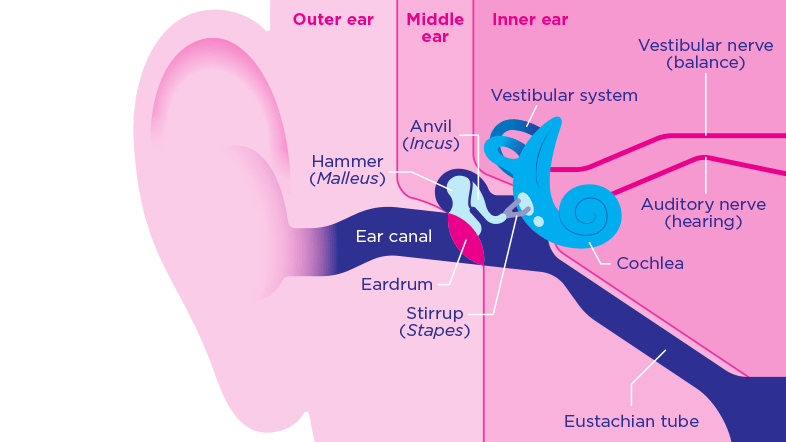Our ears are important for both hearing and balance. They have 3 parts: the outer, middle and inner ear.

Outer ear
The outer ear is made up of the pinna, which is the part you can see on the side of your head, and the ear canal. Sound waves (vibrations) are gathered by the pinna and travel down the ear canal to the eardrum, causing it to vibrate.
Middle ear
The middle ear is an air-filled space behind the eardrum that contains a chain of tiny bones called the ossicles. These are made up of the malleus (hammer), incus (anvil) and stapes (stirrup). When the eardrum vibrates, it causes the ossicles to move backwards and forwards. This movement passes the sound waves from the ear drum to the inner ear.
The middle ear is also connected to the space at the back of the nose by a small passage called the Eustachian tube. When you swallow, yawn or blow your nose, the Eustachian tube can open, allowing air into the middle ear, equalising the pressure. The Eustachian tube opening and closing can be heard as a popping sound, for example when in an airplane which is taking off or landing.
Inner ear
The inner ear has 2 main parts:
- the cochlea, responsible for hearing
- the vestibular system, responsible for balance
The cochlea is a fluid-filled chamber that looks a bit like a snail shell. It’s lined with thousands of tiny sensory cells known as hair cells.
When sound waves enter the cochlea, the hair cells trigger electrical signals in the auditory (hearing) nerve. The auditory nerve sends these signals to the brain, which recognises them as different sounds – for example, people talking or footsteps.
The vestibular system is an important part of our sense of balance. Information from the vestibular system is sent to the brain. The brain uses this information to create a detailed idea of your body movement and head position. Together, with your vision and the sensors in your joints, this helps you to keep your balance.